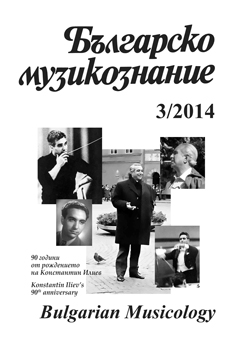Певческият репертоар за св. св. Козма и Дамян в антифонар от Уорчестър, GB-WO F.160
Chant repertory for SS. Cosmas and Damian in Worcester Antiphoner, GB-WO F.160
Author(s): Yavor GenovSubject(s): Music
Published by: Институт за изследване на изкуствата, Българска академия на науките
Keywords: Gregorian chant; liturgy; palaeography; hagiography; Antiphoner.
Summary/Abstract: The liturgy of Cosmas and Damian was established in Western Europe in the fifth or the sixth century, probably in Rome. About five centuries later, during the tenth century single chants were composed to commemorate the holy brothers. Of the available repertory, the antiphon Cosmas et Damianus Leontius, 001938 is the most notable. The chant occurs in about 30 different copies of the Antiphoner not earlier than in Antiphoner CH-SGs 391, dated to the late tenth or eleventh century. The study reveals that this antiphon probably belongs to an early corpus of melodies for the saints’ feast. Probably, at the time there was not a fully developed musical repertory for all or most of the liturgical hours. Certain copies of the eleventh and twelfth century from modem Italy contain a complete set of laudatory melodies for SS. Cosmas and Damian. An identical repertory, at least in terms of the in cipit, occurs in the Antiphoner of Worcester GB-WO F.160, about 150 years later. The article explores the repertory of antiphons in Antiphoner of Worcester. Presumably, according to observations concerning the analysed antiphons, one could differentiate two stages in the compiling of the repertory of SS. Cosmas and Damian, and the one in GB-WO F.160 is subsequent of the compiling of Cosmas et Damianus Leontius. This, in its turn, suggests that for unknown for the time being reasons, in certain regions of Italy and/or Rome, in the eleventh and twelfth century, a more special attitude towards the commemoration of the saints has been recorded, than what we know about in earlier periods. In case the assumption of the identity of the repertories for the saints from some Italian sources and the Worcester Antiphoner is relevant, it brings the question of liturgical or other interrelationships between the two cities. Answers to this question are yet to be given in future studies.
Journal: Българско музикознание
- Issue Year: 2014
- Issue No: 3
- Page Range: 65-93
- Page Count: 29
- Content File-PDF

